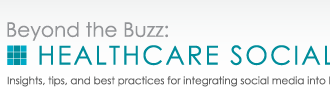 When it comes to social media, how can hospitals use it to effectively grow their patient volume? By having a clear strategy and knowing what and how to measure their efforts.
When it comes to social media, how can hospitals use it to effectively grow their patient volume? By having a clear strategy and knowing what and how to measure their efforts.
 When it comes to social media, how can hospitals use it to effectively grow their patient volume? By having a clear strategy and knowing what and how to measure their efforts. No effort is valuable unless it can be measured. Here are some great suggestions on what you can measure and the metrics you can use.
When it comes to social media, how can hospitals use it to effectively grow their patient volume? By having a clear strategy and knowing what and how to measure their efforts. No effort is valuable unless it can be measured. Here are some great suggestions on what you can measure and the metrics you can use.
In a recent article by Becker’s Hospital Review, they explain that social media “must be backed by a clear strategy for its usage and a strong methodology for measuring its effectiveness.” If hospital marketers can do just that — define a clear strategy and employ a strong plan for measuring its effectiveness — then healthcare marketers to can prove the value of social media. So, how exactly do you measure the effectiveness of social media? By defining areas to measure and clear metrics for assessment.
Here are some categories as suggested by Becker’s Hospital Review, along with suitable means of measurement for each segment:
1. Social media and market growth This category refers to social media’s ability to connect with new patients through platforms like Facebook and Twitter. It seeks to engage with consumers to prompt an opt-in action that grows the volume of patients entering your hospital system.
How to Measure: Using Google Analytics can help you track referrals from social media, and it can identify the specific sources. By means of using Google Analytics goals, you can also identify specific user actions and estimated values for each conversion.
2. Building fans through social media loyalty tactics This category refers to social media’s ability to develop a loyal and engaged audience, often through incentivizing current “fans” to take an action within your social media realms or to become a dedicated member of your fan base.
How to Measure: Some basic loyalty measurements are the number of comments and interactions you receive, as well as friends and followers. Use tools such as Facebook insights and web-based Twitter tools (TweetReach, for example, does a great job of assessing the success of a single hashtag used). Free, web-based tools abound.
3. Social media and reputation management This category of social media focuses on your reputation and how you’re perceived by others online. It focused on sentiment to ensure you convey a consistent persona and offer valuable content to your target audience.
How to Measure: You can qualitatively assess your reputation by monitoring the context and tone of comments and interactions. Also, consider using rating sites such as PeerIndex or Klout that employ an algorithm to measure effectiveness in influencing others in social media.
4. Social media and physician engagement This category of social media focuses on how your hospital’s social media is engaging with doctors from both a communication and recruitment standpoint. It’s an important sector to note since Manhattan Research says 81% of physicians use smart phones, and 90% are on social media sites.
How to Measure: Try tracking responses to physician specific campaigns, such as recruitment efforts. You can also measure usage of physician communication tools.
We work with healthcare systems, hospitals and practices to setup successful social media programs, so if you find yourself struggling to implement effective social media strategies, contact us for help.







